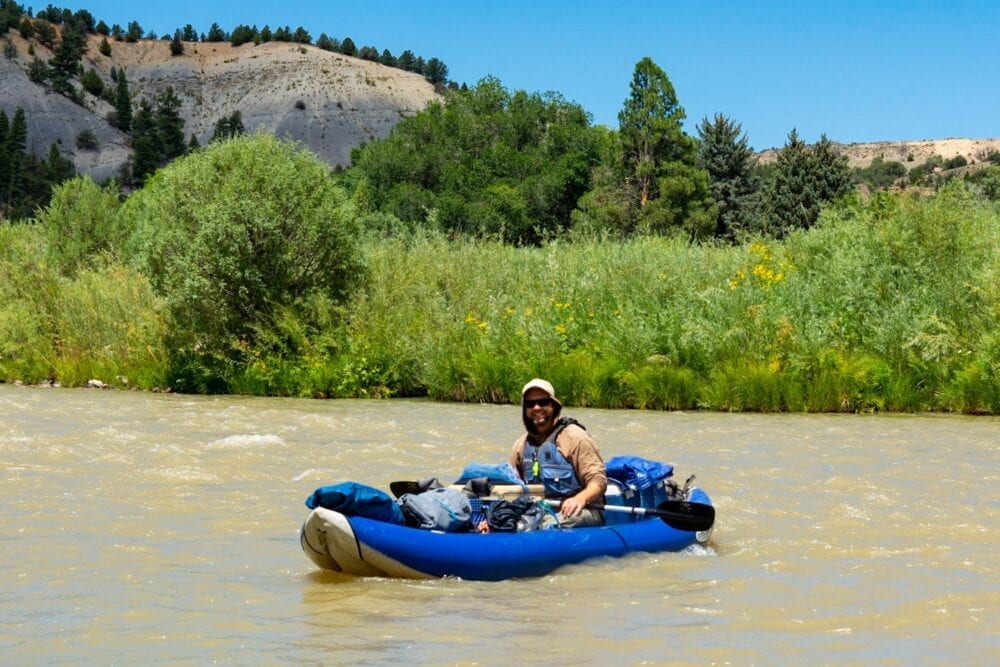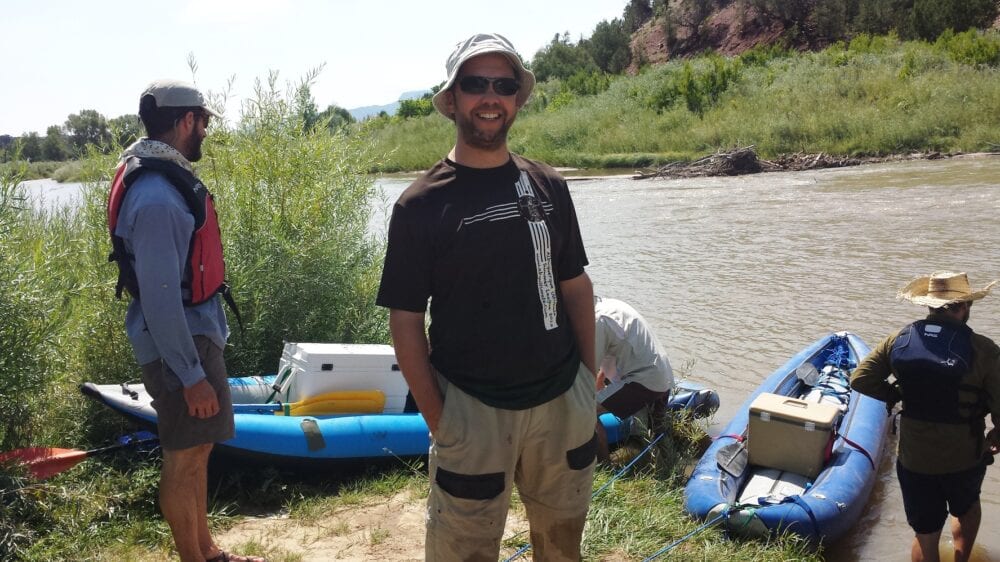Michael Scialdone is the September New Mexico Naturalist in this monthly series from the Pajarito Environmental Education Center. We hope you’ll enjoy learning about him and his work in this interview, and that you’ll join us on Tuesday, September 15 at 7 PM for a live-streamed talk on river restoration in the Middle Rio Grande Valley. Learn more and sign up here.
Location: Albuquerque, NM
Occupation: Bosque Project Manager for the Pueblo of Sandia
Favorite Place in NM: “At any given moment, it is probably any place that I’m at that is outside of a city.”
Favorite NM Critter: Tarantula Hawk Wasp
Michael Scialdone considers any day spent alongside a river to be a successful one. He goes by “Scial,” pronounced “shell,” and currently works as the Bosque Project Manager for the Pueblo of Sandia. Though his day job sounds like it might be one spent in the outdoors, he says it’s mostly a desk job.
To get his nature fix, Scial is an avid river runner, and also enjoys hiking and biking. He also spends much of his out-of-work time volunteering with the Albuquerque Wildlife Federation. The organization’s focus is to get people outside doing restoration projects to improve riparian function.
“I stay very much grounded by being involved with the Albuquerque Wildlife Federation. Just to have that connectivity with people that are also interested in getting out and giving back to the outdoors,” he says. “When your eyes really open to how damaged our landscape is, it can be overwhelming. But being around people that want to get their hands dirty, get outside, and give back, gives me hope and helps keep me grounded.”
Prior to working at the Pueblo, Scial worked on crews focused on non-native removal and native planting and as a consultant for various restoration projects in New Mexico and Colorado.
How would you define a “naturalist”?
Somebody that has innate curiosity about nature and wants to learn more about it. That can look like self education, taking classes, or just going outside and observing. The latter of those three is probably the most important — just spending time outdoors and observing all of the ways that nature operates. A naturalist is somebody that takes that internal curiosity about the world around them and looks to learn more.

When did you first start to love nature?
I don’t have an a-ha moment or anything like that. It was kind of always in me. I grew up in El Paso. My best memories are playing in the giant mulberry tree in the backyard and going to visit Cloudcroft or White Sands.
I don’t really remember not getting enthused about nature. I’ve always enjoyed digging up worms and getting into trouble. In retrospect, despite those early experiences, it wasn’t really my family’s thing, so I really started to get more into being outdoors after moving away from home.
What are your hopes or concerns for the future for nature in New Mexico?
We’re already seeing what there is to be concerned about, this crazy horrible water year is kind of a portent of things to come, and this was with an “average” snowpack. I went to college back in the 1990s and everything they were saying about climate change back then has unfortunately come true in terms of things becoming hotter and drier, not that we weren’t hot and dry to begin with here in New Mexico.
The battles, if you will, of how we’re going to have to distribute water between ecosystems and people and share that water between three states is just going to get evermore complicated. The end thing for me is, what does that mean for the ecosystem? We can argue about the economy and all of these things, which are important, but if you don’t have an environment, it doesn’t matter. My biggest concern is that we’re already seeing the reality of a climate changed world with severe wildfire and drought.
The bosque ecosystem is also drying. The bosque was a creation unto itself. Cottonwoods are not long lived trees — 80 to 100 years is old growth for a cottonwood, and that’s where all of these trees are at. The conditions to create new bosque habitat are not at the levels that they were previously and we’re not going to have floods that will generate cottonwoods. It’s going to play with our brains in a relatively short period, less than a generation. The bosque we know today is going to look different.
What are your hopes for the next generation of New Mexico children?
You hear a lot these days about “nature deficit disorder.” Kids spend too much time playing video games and watching TV, which is true, but it was also true for my generation.
I am definitely only seeing a certain group of kids through my work, but they have been immersed more in nature and issues of climate change than me and my friends were growing up, and that gives me a little hope for the future. I hear their knowledge when kids come on projects and I have conversations with them. It impresses me that they seem more educated and aware of things that it took me a lot longer to learn about.
There seems to be more people, at least here in New Mexico, that want their kids out in nature and immersed in nature. I think organizations like the Bosque Ecosystem Monitoring Program (BEMP) here in Albuquerque or PEEC help with that. It gives me a little hope for New Mexico that kids will follow in the footsteps of say Aldo Leopold, who lived here generations ago and came up with the land ethic to consider ourselves a part of this community of creatures and soil versus above it.
Learn more about Scial’s volunteer work or get involved with upcoming projects from the Albuquerque Wildlife Federation by visiting their website here.
New Mexico Naturalists is a monthly series produced by the Pajarito Environmental Education Center (PEEC) to highlight the work and experiences of people throughout the state that are making meaningful connections with nature and wildlife.
Have a suggestion for a naturalist that we should feature in the future? Email publicity@peecnature.org to let us know! PEEC is the non-profit organization that operates the Los Alamos Nature Center.

